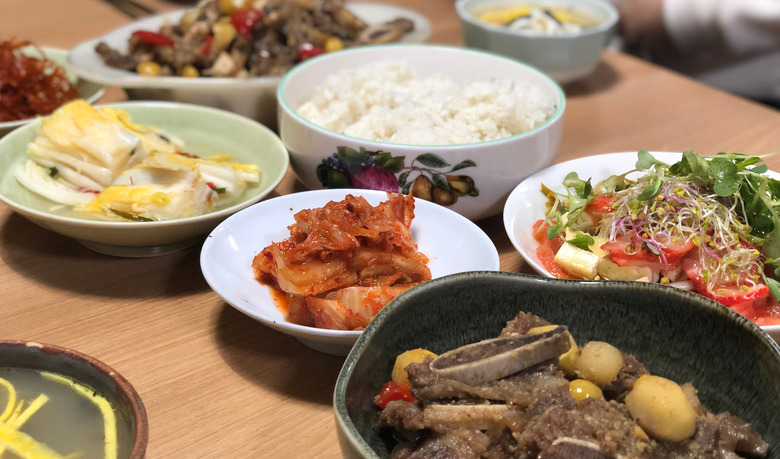Celebrate The Korean New Year
It's probably safe to say that many Americans are familiar with the Chinese New Year. But, what about the Korean New Year? Perhaps less so.
Seollal is the most celebrated holiday in Korea. It's a time to get together with family, honor one's ancestors and elders, engage in traditional games and rituals, exchange gifts, and of course, eat. There is a dizzying array of dishes prepared for the celebration, of which we've only been able to provide a small, but representative sample. Much of the gift giving and many of the rituals center around food as well, and the celebration typically starts three days before the holiday. That's a lot of eating.
Beyond basic facts though, I'm no expert on Korean culture, so to get the scoop, I was lucky enough to talk with Hyosun Ro, author of the blog Korean Bapsang, about about how Koreans celebrate this very important holiday:
Dress your family in corduroy and denim, except on Seollal...
Many people travel to visit their relatives and bring gifts to them. Women of the house work hard for days leading up to the big day to prepare the feasts. Everyone dresses up in their best clothing, usually hanbok (the traditional dress), and tries to look his or her best to start the new year with a clean slate.
In the early morning, many families perform ancestral rites, known as charae. After the rituals, the family members enjoy the feast. Then, the young people honor the elders of the family by wishing them a prosperous and healthy new year, with a deep bow called a sebae. In return, they receive cash. They also visit elders of relatives and friends and do the same. Often, families and friends gather to play traditional games during the festivities. The most popular one is yut nori, which is a board game with four wooden sticks that work like dice.
The secret to eternal youth is not to eat the rice cakes...
A must-eat dish is tteokguk (rice cake soup). It's made with garaetteok, which is unsweetened and shaped into a long cylinder. For the soup, garaetteok is sliced into thin oval shapes. The white oval shape symbolizes a bright and prosperous new year. Also, Koreans traditionally age another year on this day, rather than their birthday. It's commonly said that one must eat a bowl of tteokguk to become one year older.
There are so many other dishes prepared for Seollal, such as galbi jjim (braised short ribs), japchae (stir-fried starch noodles with beef and vegetables), mandu (dumplings), nokdu jeon/bindaetteok (savory mung bean pancakes), saengseon jeon (pan-fried battered fish), namul (vegetable dishes), various rice cakes, and hangwa (traditional sweets and cookies), just to name a few.
The prepared food is first offered to the ancestors on the ritual table. It is believed that the ancestors actually visit that day and enjoy the spread. As such, food is a serious matter and very carefully prepared. Only after the ritual, the food is served to the family members and other visitors.
Why I'd love to come, but you're halfway around the world...
Since the Lunar New Year is not a holiday in the U.S., it's usually difficult for out-of-town family members to get together. My kids, for example, haven't been home for the Lunar New Year for many years.
While various Korean community associations and cultural centers hold festivals and events to celebrate the Lunar New Year, for most Korean-American families, it's a day to spend quality family time. They most likely eat tteokguk as well as some other traditional dishes.
However, I don't think gift giving is as prevalent as it is in Korea. Some older generations, like my parents, still continue the tradition of ancestral rites in the States. When they were still working, my parents used to observe the rituals the night before because they had work in the morning. My father thought it was OK because the night before is the morning of the new year in Korea due to the time difference, so the ancestors would understand.
Even the gifts revolve around food...
Traditionally, gifts include money and food items. Popular food gifts are meat (especially high quality cuts of beef such as short ribs), dried fish, fruits, rice cakes, ginseng, drinks, etc. These days, stores sell many different kinds of special gift sets that include various food items.
Time to feast!
Tteokguk (Korean Rice Cake Soup)
This soup is a must for any Seollal celebration...
Mandu (Korean Dumplings)
Stuffed with cabbage, onions, and scallions, as well as pork and shrimp or beef, these traditional dumplings can be deep-fried, boiled, or pan-fried as shown here...
It's easy to make, and an anchovy stock gives this soup a subtle richness and body...
Japchae (Korean Stir-Fried Starch Noodles with Vegetables)
A great dish to share at any large celebration or traditional holiday, especially Seollal...
Galbi Jjim (Korean Braised Beef Short Ribs)
Mouthwatering beef short ribs are marinated and cooked to perfection...
Mung beans, bean sprouts, and dried fiddlehead fern come together in this traditional Seollal dish...
Four easy-to-find ingredients combine to make this unique and simple dish...
